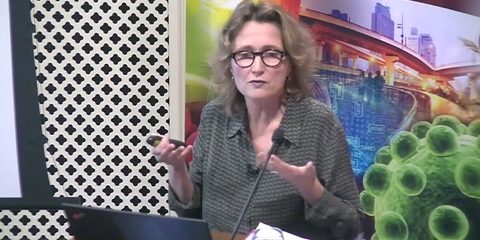
Cost a barrier for life saving asthma treatments, new study finds
Half of all adults and a third of children with asthma are missing out on essential treatment due to out-of-pocket costs, a new study has found.
A team of researchers led by The George Institute for Global Health and the Woolcock Institute of Medical Research surveyed 1400 people with asthma (adults with asthma and parents of children with asthma) across Australia and found that half of the adults and one–third of the children in the study were either decreasing or skipping doses of asthma medicines to make them last longer.
Senior Research Fellow Tracey-Lea Laba, of The George Institute, said the results published in the journal, JACI : In Practice, were especially concerning because around two thirds of adults and children had poorly controlled asthma symptoms.
“Asthma affects around one in nine Australians and is one of the world’s leading causes of death and disability. We know that preventer inhalers can be incredibly effective at controlling symptoms and preventing people from being hospitalised or even from dying of asthma, yet our study has found that out-of-pocket costs are preventing Australians from accessing medicines which can be life-saving.”
The most commonly prescribed preventer treatments for asthma contain inhaled corticosteroids (ICS), which if taken regularly reduce the severity of the disease and asthma related deaths. Unlike many other countries, Australia has a national medicines subsidy program through the Pharmaceutical Benefits Scheme (PBS), but most patients still have a co-payment. In Australia, patients with health care cards (pensioners, unemployed, single parents and people with a long term disability) pay $6.50 per prescription. Everyone else (around 40% of people with asthma) pays up to $40.30.
The study, which was funded by the National Health and Medical Research Council (NHMRC), NPS MedicineWise, and Asthma Australia, found out-of-pockets costs were leading many people to either skip or decrease dosages to make medicines last longer, and that young male adults were the most likely to under-use asthma treatments. This is compounded by GPs being largely unaware that out-of-pocket costs are a huge concern for many of their patients, or that some preventers had lower out-of-pocket costs for patients than others.
Key findings
- 52.9% of adults and 34.3% of parents reported under-using treatments to due cost.
- Three-quarters of children and adults had partly or poorly controlled asthma symptoms.
- About 40% of adults with asthma had not used an ICS-containing medication in the previous year, despite Australian guidelines recommending that these should be taken by almost all adults with asthma.
- 45% of adults and 64% of children had required urgent healthcare treatment for their asthma in the previous year.
- While differences in income did not appear to be a driving factor in underuse – a sub-class of ‘working poor families’ with asthmatic children was identified as having higher levels of underusing medications for asthma.
Fellow author Professor Helen Reddel, of the Woolcock Institute, said it was clear that prescription costs were off-putting for many people with asthma in Australia.
“It all adds up and $40 a prescription is a lot of money for people on a budget. So you can start to understand why so many people with asthma are not taking preventer medications either correctly or at all."
“But asthma is a long-term disease and one where you really need to keep the inflammation under control by taking a preventative medicine and not just relying on short-term symptom relief from a blue inhaler. We need doctors to talk to their patients to stress that this band aid approach does not work, and can leave them hospitalised or even worse as a result.”
The paper calls for urgent interventions to promote discussions between patients and their GPs about the cost of medicines, including the availability of lower cost preventer treatments.
The study was funded by the NHMRC, NPS MedicineWise, and Asthma Australia and was a collaboration of The George Institute, The Woolcock Institute of Medical Research, The University of NSW, the University of Sydney and the University of South Australia.



